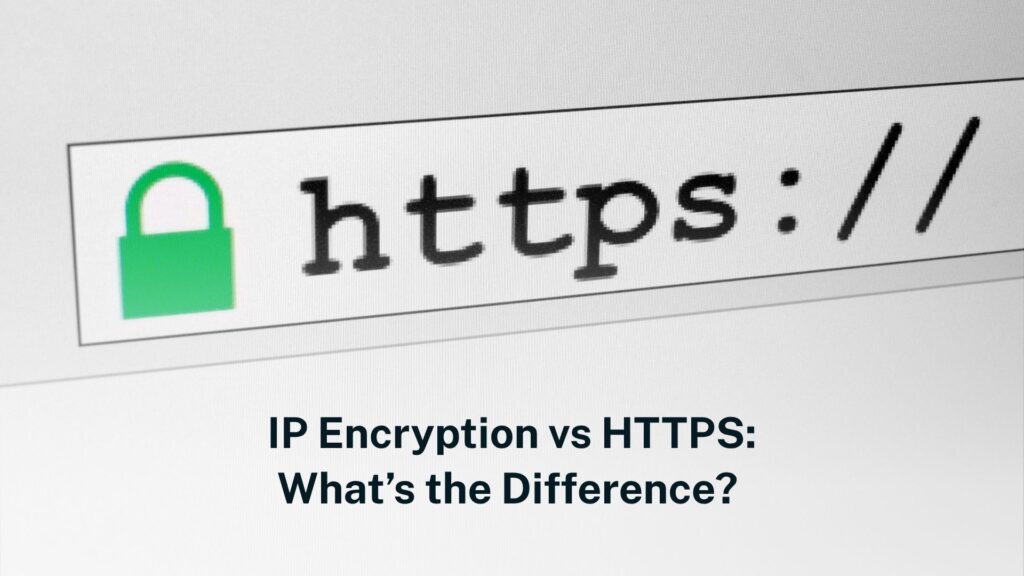
- IP encryption (commonly IPsec) protects all IP traffic—not just web—in transit.
- Strong encryption and key management are vital as threats evolve, including from quantum computing.
IP encryption refers to the process of protecting data right at the network (IP) layer by both encrypting and authenticating packets. The most widely used standard is IPsec (Internet Protocol Security). Unlike HTTPS, which secures web traffic, IPsec works invisibly beneath the application layer to protect all IP traffic—email, VoIP, file transfers, cloud services—across IPv4 and IPv6 networks. It is a protocol suite defined by the Internet Engineering Task Force (IETF).
How IPsec works
IPsec is built from several key components. Authentication Header (AH) ensures the packet’s integrity and origin, and helps prevent replay attacks, though it does not encrypt payloads. Encapsulating Security Payload (ESP) encrypts the data and optionally the IP headers, also ensuring integrity and authenticity. Internet Key Exchange (IKE/IKEv2) negotiates keys and policies (Security Associations) between peers, using protocols such as Diffie–Hellman and X.509 certificates. Security Associations (SAs) define the cryptographic parameters, such as keys, algorithms, and lifetimes to apply for a given session. In essence, IKE establishes the secure tunnel, and ESP/AH secure the data inside.
Why encryption and authentication matter
Encryption ensures that only authorised parties can read the payload, while authentication confirms who sent the packet and that it hasn’t been tampered with. Both are essential to protect against passive monitoring and active interference in transit.
Symmetric and asymmetric cryptography in action
IPsec combines symmetric encryption like AES across ESP, offering fast, efficient confidentiality, and asymmetric cryptography during IKE, such as Diffie–Hellman and RSA, establishing secure session keys without prior shared secrets. This hybrid design balances performance and security.
Real‑world uses of IP encryption
IPsec underpins many everyday secure connections. For example, when you use a work VPN at home, IPsec silently encrypts your data back to the corporate gateway. IoT devices often include embedded IPsec stacks to protect telemetry sent to cloud servers. Enterprises create IPsec tunnels between branch offices or cloud services to enforce security policies and ensure compliance.
Behind the scenes: transport and tunnel modes
IPsec operates in two modes. Transport mode encrypts the payload but leaves the original IP header intact. Tunnel mode wraps the entire original IP packet—including header—inside a new packet. This is commonly used for site‑to‑site VPNs or secure gateways. Choosing the right mode depends on use cases—remote access versus network-to-network security.
Configuration complexity and compatibility
Although powerful, IPsec can be challenging to configure. Administrators must set correct modes, select algorithms such as AES-GCM or ChaCha20-Poly1305, manage key lifetimes, and ensure NAT traversal is enabled. Some devices lack full support, and firewalls or NAT devices can interfere with key exchanges unless special measures are configured.
Performance and hardware acceleration
Encrypting and decrypting each packet adds overhead. However, modern CPUs with crypto acceleration (AES-NI) and even specialised VPN hardware significantly reduce this, ensuring that performance remains usable—even on high-throughput links.
Preparing for the quantum future
Quantum computers pose a threat to current asymmetric algorithms. Institutions like NIST and IETF are working towards post‑quantum cryptography to integrate quantum-safe algorithms into IKEv2. Emerging research explores quantum key distribution to secure IPsec tunnels at scale. A recent study demonstrated 100 Gbps quantum-safe IPsec tunnels protected by quantum key distribution—highlighting real-world progress.
Expert perspectives
Security experts consistently stress the importance of encryption. According to Cloudflare, IPsec “helps keep data sent over public networks secure.” A network engineer from Aviatrix asserted that IPsec delivers “better end‑to‑end security” than MACSec for cloud connectivity. Reddit discussions among practitioners highlight that Microsoft recommends GCMAES256 for best throughput, balancing performance and integrity. These viewpoints reinforce that excellence in both encryption strength and implementation robustness are essential.
Best practises for robust IP encryption
To achieve strong security, use modern ciphers such as AES-GCM or ChaCha20-Poly1305. Enforce strong authentication through certificates or secure PKI rather than pre-shared keys. Ensure NAT traversal is supported for wider compatibility. Rotate keys regularly to limit potential exposure. Stay quantum‑ready by monitoring and adopting post‑quantum extensions when available.
Everyday encounters with IP encryption
Most people use IP encryption every day without awareness. When your company VPN connects, IPsec is quietly securing your traffic. Smart devices check in to servers using embedded IPsec stacks. Organisations use encrypted tunnels to enforce security, compliance and auditing across branches and cloud services.
FAQs
1. What’s the difference between IP encryption and HTTPS/TLS?
IP encryption secures everything at the IP layer, protecting all traffic regardless of application. HTTPS/TLS only secures web traffic.
2. Can IPsec encrypt all my internet traffic?
Yes. In tunnel mode, IPsec can encrypt all traffic between two gateways, effectively securing all transit data.
3. Is IPsec hard to set up?
It has a reputation for complexity due to various modes, algorithms and NAT-related issues. But modern tools and appliances simplify deployment.
4. Will quantum computing break IPsec?
Quantum computers threaten the asymmetric part of IPsec. The transition to post‑quantum key exchanges is already underway.
5. How can small businesses use IP encryption?
Even small firms can use IPsec-enabled routers or VPN appliances to protect remote access and branch connectivity.
